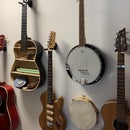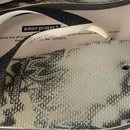Introduction: Cupboard With Folding Table and Lights
Table was really the main point of the cabinet.
I tend not to do my electronics projects unless my wife is away because I hate packing up the dining table each evening and getting it all out again. The idea with this is, that everything can be hastily shoved back in the cupboard, the table can be folded up and the doors closed. However messy it is on the inside doesn't matter because it will all look tidy on the outside. (Perhaps a metaphor for how we mistakingly live life?)
Before you do anything with to start, figure out all the details. How big you want your table is a huge part of the design in the cupboard. Also how high you want your table is important because the cupboard will have to be the at least height of the table plus the height of the table when folded away. The width of your table will also be the minimum width of the cupboard and you will want a little clearance for any mistakes and misalignment.
Step 1: Building a Big Box.
I bought some ply from the store and found some more in a skip bin outside a construction site.
The heavy duty stuff!! Whoop whoop!!
My wife and I like the look of tongue and groove timber with a light whitewash over it.
So I clamped a straight edge to the ply and ran the router down it with a v bit.
Now it looks kinda like tongue and groove. This was one great way to make $40 ply look like $80 ply.
If you don't have a router, I'm sure that you could achieve the same affect by setting a skill saw at 45 degrees and having the blade hanging down only slightly more than the width of the blade.
Our measurements were based on the size of the stuff we wanted to put in it and because we use metric in New Zealand, I went with 400mm by 1m. It was a good size for my wife's overlocker. It also meant the cupboard could fit behind a strangely placed door in the corner of our dining room. We went with the height of a door, because it would look like it fit nicely in any house.
I divided all the measurements by 100 and drew them down on paper to check scale and how it would all look. (Again, thank God for metric! I honestly don't know how Americans can handle bloody imperial!) Since I like to do things cheaply, I also did the same for the sheet of ply and worked out that with this size, I could get the sides and the doors out of the same piece of ply. (Unfortunately I didn't take the width of the outer decorative frame into account. This made the door panels just a tad on the small side.)
It started raining while I was working on it outside, so I chucked the tarp off the woodpile over it. Bad move. We don't often get dangerous creatures of any kind in New Zealand, but we did import these huge spiders from Aussie. This one was about as big as my hand and scared the living daylights out of me. I managed to flick it off the cupboard and bash it in a panic of rage until I was absolutely sure it was dead. Australia can keep their hideous creatures.
Step 2: Shelves
I put a fixed shelf at table height and movable shelves on the top and bottom.
This is so easy to do.
Measure regular intervals up each corner of the cabinet and drill holes that fit the push in pins.
Cut the shelves to size.
Push the pins in at the right height and sit your shelf on top! So easy!
I spilt the cabinet in half and had two sets of adjustable shelves because one side for me and one side for my wife.
Pro tip. Make sure you don't drill right through! You can tape around your drill bit as a depth guide.
Also, don't go too close to the corners of the shelf because if the shelf moves a little, you don't want it to fall down.
Step 3: Trimmings
There was a woodstack that was owned by our landlord and was sitting on our patio taking up heaps of space. They started saying things like, "We should get rid of that, it's been there 14 years and we've not used it yet." Then they starting saying things like, "If you want to use any of it, feel free. If you find anything rotten, just get it thrown out or sell it for us."
So, I scoured through it. Found some beautiful New Zealand native hardwoods. I built a bed out of Rimu and a wee cookbook stand, and discovered the wood that I built this cupboard out of. Not sure what it is, but it's beautiful and has a super straight grain.
Everything was in 8 by 2 planks. Massive long lengths, way too fat to use and I don't have a table saw.
So I conjured up the idea to rip it all down with a skillsaw.
The sequence went like this.
Rip it down.
Plane it with an electric planer
Route the edges all fancy
Give it a sand
Cut to size
Paint
Pro tip:
If you have access to a table saw and a thicknesser, this whole thing will be so much easier and way more accurate.
Step 4: Fold Down Table
The basics of building your own are this.
Figure out the height you want your table.
Step 5: Doors
Doors were friggen hard for a number of reasons.
1. I've never made doors before.
2. I didn't make them perfectly square
3. I didn't calculate the added width the trimmings added to the cupboard when I first cut the ply for the doors.
4. The screws I had were too long for the width of the timber and the hinges needed large headed screws.
5. I made them a little bit big and had to route them in a bit to make them fit.
Things I learned:
Make sure the doors are square and flat when you glue them all up.
Ply is prone to warping so cut it the full size of the frame, glue and screw it real good.
If the top and bottom hinges are exactly even on the door, the door will close evenly.
If they are even on the cupboard, they will open evenly. Try go for both, but if you have to choose, the closed doors take precedence, because badly closing doors are really annoying. Once the door is open, you won't notice it being a little bit out.
Magnetic door catches are easier to fit if the cupboard doors go all the way to the top of the cupboard. (I had a trimming and I had to make a custom packer behind it for them to screw onto)
Step 6: Fancy Folding Lights!
I had a few different ideas for how the lights would fit into the cabinet, but eventually went with concertina style.
It allowed a fairly compact light to extend out quite far and didn't seem too hard to make.
I tried a few different configurations with how to make a locking mechanism. My wife came up with this genius idea of routing in slots and leaving the bolt sticking out of the bottom. It's by far the easiest to use and make. I toyed with having them on a dowel or having a small rotating wheel that bought it in and out, but there were loads of problems with the idea.
The main thing with this idea is to make sure that the routed slots fit perfectly for the fully extended and fully retracted positions. The middle routed line also had to match the middle bolt when fully retracted. The other two just went halfway between the others.
I also found that as the concertina was extended, moving it up to the next notch got harder because the roof of the cabinet would get in the way of lifting it to get it into the slot. I got around this by routing an angle onto it so that the top notch was shallower than the others (see the pictures to get what I mean).
Step 7: Power!!
The wiring in these photos may differ country to country due to different sockets.
It may also differ depending on the brand of plug.
This step is less of a how to, and more of a how I did it.
You will need to do your own research on the type of plug, lights and cables that you work use in your country
Step one, make sure everything is unplugged until the end!!
Step two, keep in mind that 240volts of electricity can kill you. If you don't know what you are doing, get advice. I'm fairly confident with these things, but I still sent a photo to a registered electrician (my dad) before plugging it in and turning it on. All the parts had been supplied by him and he gave me advice on how to wire it
I cut an old extension cord for the cable. If you do this, it pays to have one with an earth wire, but some countries don't have earth connections.
I cut a hole in the back of the cabinet and mounted a power box into the fold down table.
In the power socket that I had, there was two plugs and three switches. The middle switch was for the lights.
I wired up the plugs with green earth, blue negative and brown positive. On some cheaper cables, these might be other colors or just wrong, test yours with a multi-meter and do your research.
If you wire the earth power wrong, you might plug in something as simple as your sewing machine and get a 240volt shock off the needle.
With the lights I bought a cable with two cores and a black and red wire. I chose the wire because of it's flexibility. Some cables are designed to flex and some are designed to be in place and will break with too much bending.
Choose the cable that best suits your need.
I wired the negative (black) light cables into the same point as the negative blue from the plugs.
I checked the switch with a multimeter to figure out which contacts would connect when switched on.
I wired one of those points with a loop back to the positive point on the plug and wired the red positive of the light cables onto the other point.
At the bulb end of the light, it's just a matter of connecting them up where they say.
It is important to screw the wires up nice and tight, because you don't want the bulb to fall off the end and leave 240volts of bare wires sticking out.
Step 8: Fill It Up and Enjoy!!
Left for me, right for my wife! Works like a charm! Board games go underneath and can be played on top.
Yesterday was carcassone. Haven't given it the total space test of multiple player agricola, but plan to in the future! The lights above make it awesome for games and projects.






